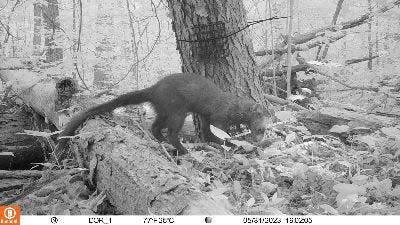An animal that disappeared from Ohio for over a century is making a comeback

A mammal that disappeared from Ohio in the 1800s is making a comeback, and state biologists think it's here to stay.
A fisher, a mammal related to river otters and weasels, found as roadkill in Ashtabula County in 2023, was recently confirmed to be pregnant, according to the Ohio Department of Natural Resources. Although that fisher did not give birth, state biologists say it's a sign that fishers are colonizing Ohio.
What is a fisher, sometimes incorrectly called a fisher cat?
Despite frequently being called a "fisher cat," fishers are not cats, nor do they catch fish. They are forest-dwelling carnivorous members of the weasel family.
They mostly live in southern Canada, New England and New York, but can be found in scattered locations in Pennsylvania, West Virginia and Virginia.
Fishers have a weasel-like body, bushy tail, tapered muzzle, and low rounded ears. Adults grow to a length of 20 to 25 inches, excluding the 13 to 16.5-inch tail, and can weigh between 3 and 15 pounds. Males are larger and heavier than females.
They hunt rodents and other animals, both in the trees and on the ground. Their diet also includes fruits and nuts.
Fishers in Ohio
Fishers disappeared from Ohio by the mid-1800s, as settlers cleared their habitat and hunted them to near-extinction, according to Farm and Dairy. Since then, there have been 40 confirmed fisher sightings across nine northeast Ohio counties (Ashtabula, Columbiana, Geauga, Trumbull, Mahoning, Lake, Jefferson, Harrison, and Tuscarawas), according to ODNR. Two-thirds of those -- about 26 sightings -- happened in the past three years. They are moving westward from established populations in Pennsylvania and naturally colonizing Ohio.
The ODNR Division of Wildlife collects roadkill fishers found in Ohio to determine age and test genetics. In February 2023, biologists collected two roadkill fisher carcasses from northeast Ohio. Recently received laboratory results showed that one of the animals was pregnant. The Division of Wildlife anticipates natural reproduction in fishers will be confirmed in the coming years or may already be occurring.
Fisher vs. mink. What animals are in the same family?
Fishers are a mustelid (family Mustelidae), which includes about 55 species of ferrets, polecats, badgers, martens, otters and weasels, among others.
They are often confused with their cousin, the mink, according to the U.S. Forestry Service. But minks are smaller, measuring 12 to 16 inches head to tail and weighing 1-2.25 pounds. They have a small, white patch on chin and/or throat/chest, and have a shorter, less bushy tail.
How to report a fisher sighting
The Division of Wildlife relies, in part, on public reports to monitor Ohio’s growing fisher population, as well as black bears, badgers, weasels, and bobcats. Report observations, including photos or videos, to the Division of Wildlife via the HuntFish OH mobile app or at wildohio.gov. Contact your county wildlife officer to report roadkill fishers. It is not permitted to collect roadkill carcasses.
This article originally appeared on Record-Courier: What is a fisher? Mammal related to mink making comeback in Ohio
